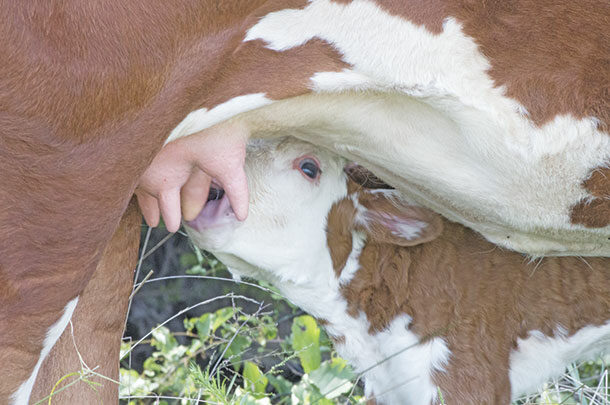The need for livestock producers to match cow size and milk production potential to forage resources in order to optimize forage utilization and reproductive efficiency is critical. Matching nutrient availability of the forage base with nutrient requirements of the cow has been recommended to efficiently utilize forage quality.
However, in beef production, we tend to overdo selection with the mentality that “more is better” or “bigger is better” in efforts to increase production. Selection for growth-oriented maternal traits has been a focus in the beef industry in an effort to maximize output. In doing so, cow-calf producers have tended to select for short-term traits such as growth and milk yield to increase weaning weights of calves for the potential to increase profitability.
With that in mind, using phrases such as “She’s a good milker” or “I need cows that can milk” begs the question: Are you actually getting the full benefit of that milk you’re paying for? For instance, benchmarking data from North Dakota State University illustrate calf weaning weight has been stagnant for the last 20 years or more. At the same time, genetic potential for growth has increased steadily.
Using maternal genetics, calf weaning weight has been shown to have as low as 5 percent influence on profitability on the ranch. With selection of milk, we are chasing a mere 5 percent influence on profitability. On the other hand, the economic value of reproduction is reported to be 5 times greater than calf growth or milk traits.
In addition, increased milk production increases production costs and inputs. With feed costs, which typically run between 60 to 75 percent of total annual cow costs, matching cow type or genetic potential to the production environment is and will be more important as the cost of production increases.
In a study conducted at the University of Tennessee, 237 Angus-bred beef cows were milked with a milking machine at days 58 and 129 postpartum to determine the influence of actual milk production on cow-calf performance. After milking, cows were retrospectively classified into one of three milk yield groups: low- (14 pounds per day), moderate- (20 per day) or high- (26 per day) milk cows. Pregnancy rates after A.I. were 11 and 13 percentage points lower for high-milk cows compared to moderate and low cows, respectively.
The decreased pregnancy rate after A.I. in the high-milking cows continued through the entire breeding season, with high-milking cows having the lowest overall pregnancy rates. Interestingly, milk production level did not increase calf weaning weight. Even with the nearly double milk production from low to high, calf weaning weights were not different among the three groups. A cow milking 14 pounds per day weaned the same size of calf as a cow milking 26 pounds per day.
However, the production costs between the two are drastically different, with costs being greater in the 26-pounds-per-day cow. Previous studies in Montana have shown milk production only influences calf average daily gain (ADG) up to peak lactation, which is roughly 60 days after calving. Calves from lower-milking cows tend to graze more in order to offset the lower consumption and availability of their dam’s milk yield, which can provide similar ADG if forage quality is high.
With current trends of selecting for increased output-oriented traits in purebred and commercial herds in the U.S., average milk production at peak lactation has been steadily increasing. The continual increase in selection for milk production in beef cows increases the nutritional stress in critical physiological periods, such as early lactation, and will ultimately reduce reproduction or increase production costs to maintain performance. Even in environments with high-quality feed, reproduction can be decreased in mature beef cows when peak milk production is greater than 20 pounds per day.
Summary from the study mentioned above:
- Selecting for increased milk production carries increased production risks.
- Environment and management can restrict genetic potential to fully express themselves.
- Selection of production traits that exceed the capacity of the production environment may not increase output (i.e., weaning weight) but will increase production costs of the cow herd.
- Selection for milk production in beef cows increases the nutritional stress in critical physiological periods, such as early lactation, and can reduce reproductive traits or increase production costs to maintain performance.
If milking potential in the cow herd is too high, you may start seeing:
1. Calving distribution can start to spread out from increased number of later-breeding cows
2. Decreased pregnancy rates especially in young (2- and 3-year-old) cows
3. Decreased stocking rates over the years than previously stocked due to increased intake
4. Increased number of thinner body condition score cows or increased feed amounts to maintain adequate body condition score ![]()
PHOTO: Even with high-quality feed, reproduction can be decreased in mature beef cows when peak milk production exceeds 20 pounds per day. Photo by David Cooper.
Portions of this article previously appeared in the March 2019 UNL Beefwatch newsletter.

-
Travis Mulliniks
- Range Cow Nutritionist - University of Nebraska
- West Central Research and Extension Center
- Email Travis Mulliniks












